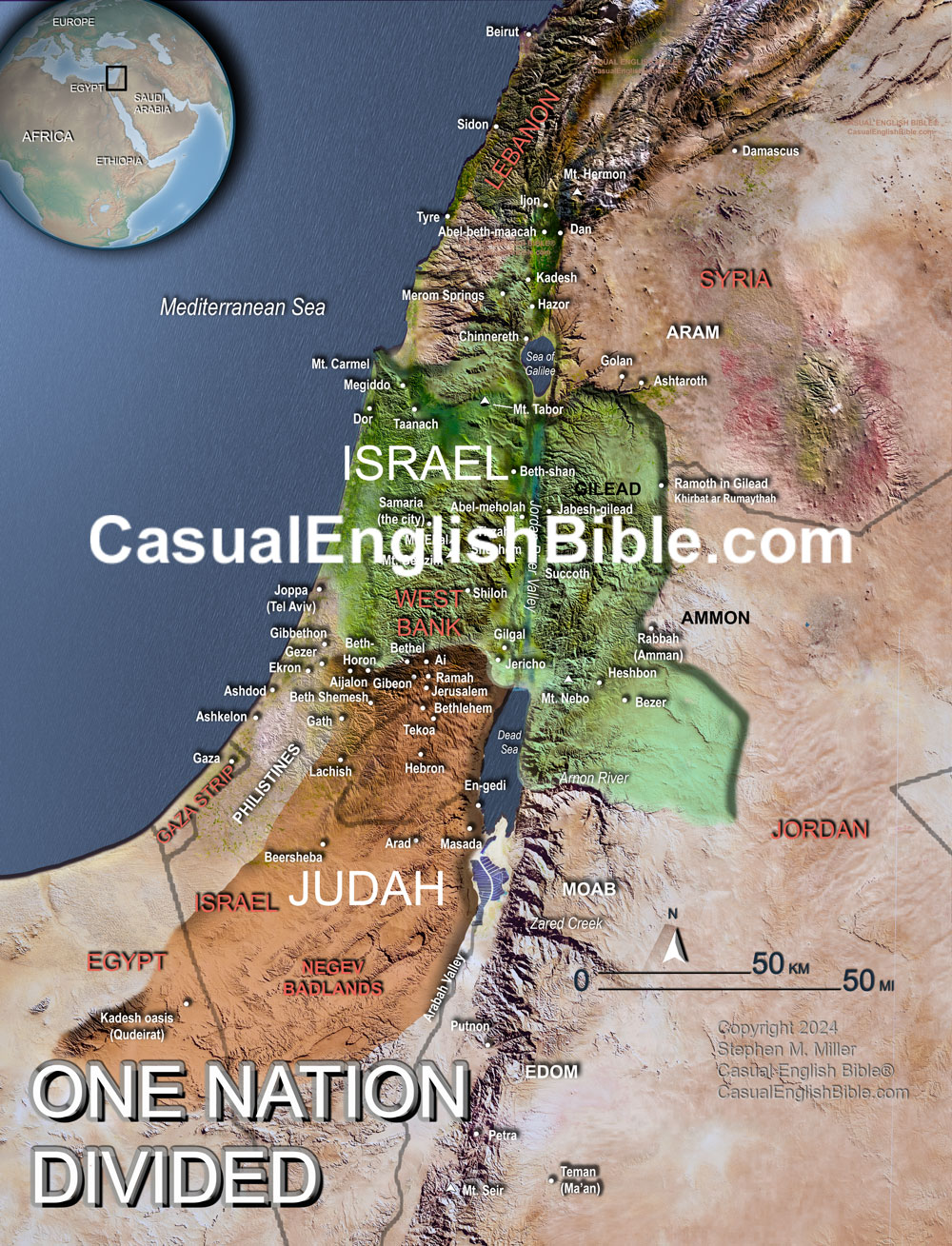2 Chronicles 17
Officials teach God’s law to cities
New king: Asa’s boy, Jehoshaphat
1Asa’s son Jehoshaphat became the next king of Judah. He strengthened his defenses against Israel in the north. 2He posted soldiers in walled cities throughout Judah and in towns his dad had captured from the tribe of Ephraim. He also set up other defensive stations [1] throughout the land as well.3The LORD helped Jehoshaphat because the king obeyed the laws of God, just as his father Asa did during the early years of his reign. Jehoshaphat didn’t worship the native gods in Baal’s gallery of gods. 4He stuck with the God of his father. He didn’t abandon God the way the northern tribes of Israel had done. 5For this, the LORD secured the king’s position in Judah. People supported the king by bringing him gifts and donations as his salary, or tribute. That made him a rich man.
6Jehoshaphat was aggressive when it came to protecting the faith and Judah’s contract with God to obey him. When people set up pagan shrines and sacred poles [2] on Judah’s hilltops, the king had them torn down.
Israelite evangelists hit the road, teaching the laws
7Jehoshaphat told five of his officials [3] to travel throughout Judah and teach the people. He did this during the third [4] year of his reign. The officials he chose were Obadiah, Zechariah, Nethanel, and Micaiah.8They took two priests and nine of their Levite assistants. The priests were Elishama and Jehoram. Their assistants were: Shemaiah, Nethaniah, Zebadiah, Asahel, Shemiramoth, Jehonathan, Adonijah, Tobijah, and Tob-adonijah.
9They brought the book [5] that contained God’s laws. And the team of men traveled throughout Judah, teaching God’s laws to everyone.
Nations were afraid of Judah
10Judah’s neighbor nations didn’t want any part of a war with Judah. They were afraid of Judah’s God.11Philistines brought him silver and other gifts, to stay on his good side. Arabs brought him 7,700 male sheep and 7,700 male goats. 12Jehoshaphat continued to strengthen his position as king. He built defensive fortifications throughout Judah along with warehouse cities to store his supplies.
One million soldiers to guard the king
13And he had a lot of supplies distributed among the cities. He kept some of the most seasoned soldiers in Jerusalem. 14The soldiers of Jerusalem were grouped by their family clans—their extended families. These were the commanding officers from Judah’s tribe:Adnah commanded 300,000 soldiers. [6]
15Jehohanan commanded 280,000 soldiers.
16Amasiah, son of Zicri, commanded 200,000 soldiers. He enlisted in the army.
17These were the commanders from Benjamin’s tribe:
Eliada, a brave fighter, commanded 200,000 soldiers—all armed with bows and shields.
18Jehozabad commanded 180,000 soldiers.
19This wasn’t the full army. This was only the part of the army stationed in Jerusalem, to protect and serve the king. Jehoshaphat had other soldiers scattered throughout the land he controlled.
Footnotes
The meaning of the Hebrew word for “defensive stations” isn’t clear in this context. Many translate the word as “garrison.” Some speculate that it could mean villages and communities without protective city walls. Perhaps Jehoshaphat posted a large company of soldiers in walled cities, with smaller units assigned as guards and messengers in open areas, especially throughout northern Judah and the tribal territory of Benjamin.
These poles may have been trees or poles meant to represent trees, as symbols of a Canaanite fertility goddess known as Asherah, goddess of motherhood. She was the love interest of Baal. He was chief god of the people who lived in Canaan, now known as Israel and Palestinian Territories. People worshiped Asherah with sacred poles described as repulsive and obscene. But we’re left to guess how the people used those poles in worship.
Surprise. People assigned to lead the mobile ministry of telling everyone about God and his laws were not priests, Levites, or ordained preachers. They seem to have been laypeople the king trusted. But he equipped these lead evangelists with priests and Levite associates who, presumably, helped them prepare and deliver their messages.
Some speculate that Jehoshaphat’s third year may have been his first year as sole king. It’s possible that he served as king during the final years of his father, Asa, who was struggling with a foot illness that became critical.
What book? That’s the question. The most common guess is that it was the five anonymous books attributed to Moses, which are the first five books of the Bible: Genesis, Exodus, Leviticus, Numbers, Deuteronomy. Another guess could be just Deuteronomy. It concisely summarizes some of the most important teachings and laws. Whatever it was, it seems to have been an early edition of what became part of the Jewish Bible and part of the Christian Old Testament.
By the time we finish adding the numbers, it seems the king has a standing army in Jerusalem of 1.1 million men. That would fill about 16 average professional football stadiums of 70,000 souls each. Scholars suggest two solutions they say would help these numbers make sense. One approach: Translate the word for “clan” into “unit.” So, instead of someone commanding 300,000 soldiers, they commanded 300 units. A unit may have been just two or three. Those numbers would add up to more sense, some say. Another approach: Reinterpret verse 19 and suggest that this was the entire army. It may have been headquartered in Jerusalem but assigned temporary duty throughout Judah’s territory.
Discussion Questions
- Sorry, there are currently no questions for this chapter.







